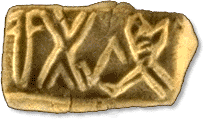Parpola's Methodology of Decipherment

Parpola's methodology for deciphering the Indus script consists essentially of two parts, namely the rebus principle generally applicable to all ancient logo-syllabic scripts and the linguistic techniques applicable to Dravidian.
Word-signs (one sign for each word) first developed from pictures.
Inscribed object from Harappa
It was then discovered that a word-sign could also be used to represent any other word with the same sound but having a different meaning. Such sets of words are known as homophones (as in English can (noun), 'a container' and can (verb), 'to be able to'.). Thus a sign which is pictorially easier to draw can be used to represent another word with the same sound, but the meaning of which cannot be depicted by pictures as, for example, abstract nouns, grammatical particles and proper names. This technique, employed in all ancient logo-syllabic scripts, is known as rebus writing (from Latin rebus, 'by means of things').
Parpola is careful to point out that rebus writing can be deciphered only if four conditions are simultaneously fulfilled:
1. The object depicted by the word-sign can be recognised.
2. The word-sign has been used phonetically for a homophone with a different meaning.
3. The intended meaning can be deduced from the context.
4. Linguistically satisfactory homophones can be found in the presumed language.
The last point leads to the second stage of the operation with Dravidian linguistic techniques. According to Parpola the signs of the Indus script are likely to represent Dravidian mono-syllabic roots. In Proto-Dravidian the bare stem could stand for inflected forms. Parpola believes therefore that it may not have been necessary to mark the case-endings in the Indus script. In principle only words and forms reconstructable for Proto-Dravidian are acceptable for the decipherment, and in such reconstruction one must follow strictly the rules established by comparative linguistics. Variations between short and long vowels and single and double consonants may however be allowed subject to Dravidian morpho-phonemic rules.
As a set of rules, Parpola's formulations are unexceptionable. However he does run into problems in applying them in practice,partly because the rules themselves are difficult to apply with precision, and also because he occasionally transgresses his own rules as we shall see presently.
